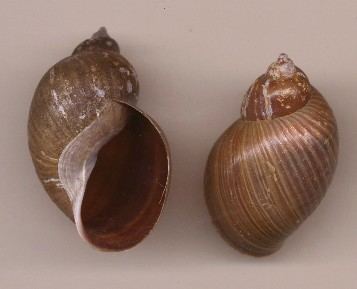Rank Family | Scientific name Lymnaeidae | |
 | ||
Superfamily LymnaeoideaRafinesque, 1815 Lower classifications | ||
Pond snail lymnaeidae 170510 yt wmv
Lymnaeidae is a taxonomic family of small to large air-breathing freshwater snails, aquatic pulmonate gastropod mollusks, that belong to the clade Hygrophila.
Contents
- Pond snail lymnaeidae 170510 yt wmv
- Pond snail lymnaeidae 220510 part three wmv
- 2005 taxonomy
- 2013 taxonomy
- Cladogram
- Genera
- Distribution
- Description
- Ecology
- References

Lymnaeidae is the only family within the superfamily Lymnaeoidea (according to the taxonomy of the Gastropoda by Bouchet & Rocroi, 2005).

Pond snail lymnaeidae 220510 part three wmv
2005 taxonomy
Bouchet & Rocroi (2005) recognized four subfamilies within Lymnaeidae:

2013 taxonomy

Vinarski (2013) established a new subfamily Radicinae within Lymnaeidae, but be considered position neither of Lancinae nor of extinct genera.
Cladogram
Correa et al. (2010) examined phylogenetic relationships among 50 taxa of this family using a supermatrix approach (concatenation of the 16S, internal transcribed spacers ITS1 and ITS2 genes) involving both maximum likelihood and Bayesian inference. Her phylogenetic analysis demonstrates the existence of three deep clades of Lymnaeidae representing the main geographic origin of species (America, Eurasia and the Indo-Pacific region). It demonstrates that the nomenclature of most genera in the Lymnaeidae does not reflect evolutionary relationships.
A cladogram based on sequences of 16S, internal transcribed spacers ITS1 and ITS2 genes showing phylogenic relations of Lymnaeidae by Correa et al. (2010):
The nomenclature of genera has been one of the most confusing issues in the Lymnaeidae systematics. Most genus names are not fixed and are based more on phenotypic resemblances than on sound evolutionary and phylogenetic considerations. For instance, a single genus in Lymnaeidae was recognized by Walter (1968), two by Hubendick (1951), and up to 34 genera by others. Results by Correa et al. (2010) indicate that genera in Lymnaeidae do not reflect phylogenetic relationships, to the notable exception of Radix (including Radix natalensis).
The type species of Lymnaea is Lymnaea stagnalis Linnaeus, 1758; the type species of Stagnicola Jeffreys, 1830 is Stagnicola palustris (= Lymnaea palustris); and the type species of Omphiscola Rafinesque, 1819 is Omphiscola glabra. However, it is clear that these three species belong to the same clade (C2) and that Lymnaea is not a monophyletic group. Correa et al. (2010) proposed that species of clade C2 should all be called Lymnaea, according to the principle of priority of the International Code of Zoological Nomenclature (ICZN). By extension, Stagnicola should not be used to name species in clade C1a since the type species belongs to clade C2. Meier-Brook & Bargues (2002) suggested including Stagnicola emarginata, Stagnicola elodes, Stagnicola catascopium and Lymnaea occulta within a new genus Catascopia, while Stagnicla caperata would belong to the genus Hinkleyia Baker, 1928. The phylogeny by Correa et al. (2010) does not conflict with this nomenclature, although it would seem preferable to identify all species of clade C1a with the same name to reflect the close evolutionary relationships among these species. Hinkleyia would be the preferable name according to the ICZN. On the other hand, at least four genera names have been used for species of clade C1b: Lymnaea Lamarck, 1799; Galba Schrank, 1803; Fossaria Westerlund, 1885; and Bakerilymnaea. In the light of the present results, it would be preferable to unify nomenclature. According to the ICZN, Lymnaea should be the unified name, but given that the type species belongs to clade C2, Galba could be a more appropriate name. Finally, as said above, Austropeplea Cotton, 1942 is not a monophyletic group, and employing the genus Kutikina Ponder & Waterhouse, 1997 (one species: Kutikina hispida) seems unjustified on the basis of the current phylogeny. This would also be consistent with results of Puslednik et al. (2009). It would be preferable to use Bullastra Pfeiffer, 1839 for all species of clade C3a to fit the ICZN.
Genera
Genera in the family Lymnaeidae include:
subfamily Lymnaeinae
subfamily Amphipepleinae Pini, 1877 (synonym: Radicinae Vinarski, 2013)
subfamily Lancinae
† subfamily Scalaxinae
† subfamily Valencieniinae
subfamily ?
Distribution
Lymnaeidae snails occur worldwide, however, most species occur in the Palearctic and Nearctic regions. An unidentified fragmentary lymnaeid from deposits of the Meyer Desert Formation (reported in 2003) was the first freshwater snail recorded from Antarctica.
Description
This family exhibits a great diversity in shell morphology but extremely homogeneous anatomical traits. Diversity of shell morphology is linked to substantial eco-phenotypic plasticity. Hubendick (1951) illustrated this point by compiling up to 1143 species names, a large number of which he synonymized. In contrast, the anatomy of their reproductive tracts (including prostate, penis and preputium) is extremely homogeneous. Immunological, cytogenetical, enzyme electrophoresis studies, and DNA-based approaches have demonstrated extensive homoplasy in anatomical characters.
Ecology
Lymnaeidae are of major medical and veterinary importance since they act as vectors of parasites (helminths, mainly trematodes, e.g., Fasciola liver flukes) that severely affect human populations and livestock, and cause important economic losses. Lymnaeids serve as intermediate hosts of at least 71 trematode species distributed among 13 families, including some species of Schistosomatidae and Echinostomatidae, with implications for human health, and Paramphistomum daubneyi, which is of veterinary interest. The most emblematic case of parasite transmitted by lymnaeids is Fasciola hepatica (Digenea: Fasciolidae), the agent of fascioliasis. Mollusks, generally lymnaeids, are required as intermediate hosts to complete the life cycle of Fasciola hepatica. At least 20 species of Lymnaeidae have been described as potential vectors of fascioliasis.
